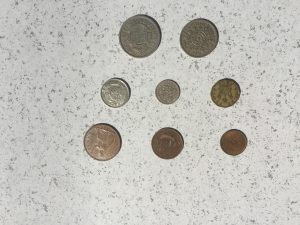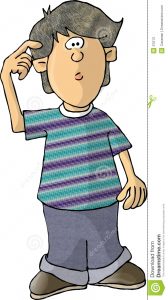
Parri has asked me to explain pounds, shillings and pence. It’s a pleasure to do so.
It’s very straightforward. Let me explain from the bottom up, in ascending order of munificence.
There are two farthings in a hayp-nie and (obviously) two haypnies in a penny. The penny is a large, confident coin, much in circulation, so tends to feature prominently in conversation, as in “A penny for your thoughts”, “In for a penny, in for a pound”, “When the penny drops”, and “Turning up (frequently and at inappropriate moments) like a bad penny”.
Mind you, the haypnie can justifiably claim to be important in reminding us of how some of the world became pink for a while on the school atlas through the travails of England’s sailing vessels, which were rarely “spoiled for the want of a haypnie’s worth of tar”. (I am inclined to believe that the reference to tar in a ship’s caulking pre-dated the tar hollered for in ‘Click go the shears’, in which the focus on ‘ship’ is replaced by ‘sheep’.)
The configuration of the penny-farthing bicycle becomes visibly clear once there is familiarity with those two staples of the currency.
Together, farthings, haypnies and pennies are ‘coppers’ – not to be confused with Dixon of Dock Green (Jack Warner) who is also.
There is no two-penny piece, except when coined in language, as in “I couldn’t give you tuppence for your old watchchain, old iron, old iron” (Lonnie Donegan).
Three pennies are of course thruppence, represented by the thruppeny bit. Just why the thruppeny bit has so different a shape and hue I don’t know. It’s almost as if it’s an interloper from across the seas, its twelve sides and strange colour promising the mystery and curiosity of far-off realms and climes.
There was also a silver thruppenny bit, scarce in my time – an anachronism with the very special added attraction of being seen only on one’s spoon amidst a piece of mum’s Christmas pud. But as the youngest of four boys, and as Parri will understand, I rarely got one – – (!!).
Two thruppeny bits make a tanner (6d) and two tanners a bob (1/-). With a tanner, a boy is rich, with his expectations in the sweet shop probably affected more by physical than financial limitations: perhaps his inability to see over the sweet shop counter.
As a cub scout I participated in ‘Bob a Job Week’ although, living on a farm, there were precious few doors to knock on so that the jobs done were probably remunerated at one shilling each by my mother – jobs which, in all probability, I ought to have been doing anyway if any sort of a son.
A two shilling piece (“two bob”) promises thrilling possibilities for a young boy – and is something of which one might boast to one’s peers. Great aunts might refer to it as a ‘florin’ but I would rather have been dead than to have used such an out-dated term.
Naturally there are twenty shillings in a quid – but never “twenty bob”. Ten bob is denominated in the first bank note of which I was aware. If you have ten bob it could be as a single orangey-brown note, ten separate shilling pieces, five two-shilling coins, or (most gratifying of all!) as four half crowns – or, less symmetrically, a combination of all of these.
You will now see that half-a-crown (the indefinite article is permissible with the singular only – “two half-crowns” not “two half-a-crowns”) is “two and six” (2/6) but never “two and sixpence”.
That’s odd because two shillings and four pence (“2/4”) is never spoken as “two and four”. I suppose that’s because two and six is denominated in a single coin, whereas two and anything else is not.
The half-crow is a coin of such heft and majesty that it requires a paragraph all its own. A boy could not pocket one without being impressed by its considerably greater thickness and weight than its cousin two bob piece – even though its value in the bank is only one-fifth greater. A half-crown is a saving or investing matter, quite over the top in the sweet shop! Together with its weight, something about its markings connotes grandness and seriousness.
A half-crown is seen now and then even by young boys. But never a crown. Never. Unless in a display cabinet in some museum after it has probably been ‘undenominated’ by the making of a hole in it and its presentation to an admiral of the fleet or a civil engineer of the Victorian period.
I have mentioned the 10 bob note – the most junior in the panoply of bank notes. Next in seniority is the pound note, followed (as a young boy I am led to understand – but not to palpably know) by £5 and £10 notes and then by who knows what possibilities above and beyond to dream about.
A pound is a quid – twenty shillings. But much of the serious masculine bidding and trading is done in guineas – including at the Fordgate clearance sale where the tyres on dysfunctional farm machinery were “on their own worth a guinea”. A guinea is 21 shillings (“21/-“) or one pound one shilling – and something one can speak of but not actually hold. There is no guinea coin or note of which a small boy in the 50s is aware.
The following glossary might help:
Denomination in farthings Shop assistant Schoolboy
farthing 1 “farthing – ma’am” farthing
haypenny 2 “haypenny – ma’am” haypnie
penny/pence (1d) 4 “penny/pence – ma’am” penny/pence
thruppence (3d) 12 ” thruppence – ma’am” thruppence
sixpence (6d) 24 “sixpence ma’am” a tanner
one shilling (1/-) 48 “one shilling” a bob (pl. ‘bob’)
two shillings (2/-) 96 ” a florin, Madam” two bob
two shillings
and sixpence or
half a crown (2/6) 120 “two and six, Madam” half a crown
ten shilling note
(no coin) 480 “ten shillings, Madam” ten bob
one pound note (£1) 960 “one pound, Madam” a quid
one guinea 1008 “a guinea, Sir” [bemused silence]
All clear, Paz?
PS: I left the UK with the tanner in 1971. The bob remained, re-christened 5p.

Should Parri enrol in Arcane Currency 201 you will of course instruct him in the place of the groat in the grand scheme won’t you?